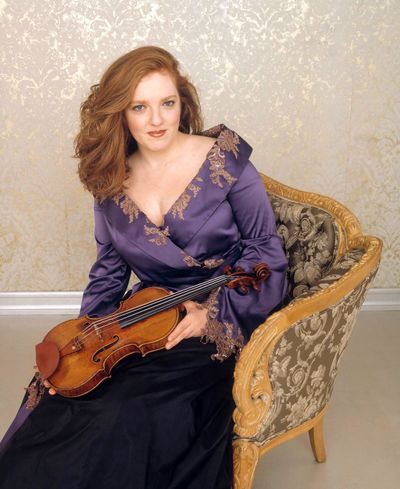Violinist Pine masters classical to metal
Playing since age 3, she sees Paganini as an early rock star

Rachel Barton Pine knows the caprices.
Composer and musician Niccolo Paganini wrote the 24 short works between 1802 and 1817 to demonstrate all the cool things one could do with a violin. To perform them all requires tremendous skill, and mastery of every trick in the violinist’s toolbox.
“It’s an amazing showcase of what the violin can do in terms of technique,” said Pine, who will perform all 24 caprices Friday as part of the Northwest Bach Festival. “More importantly, it’s an exploration of the voice of the violin, or the incredible expressive range that can be achieved by these techniques.”
Pine, who picked up the violin at age 3 and has never looked back, first performed the cycle in a single night in the late 1990s and has done it periodically since then.
“At first it was the idea of the personal challenge. There are very few people in history who have performed the whole cycle in a single evening,” she said. “Now the motivation is totally different. It’s all about really creating something that is going to be enjoyable and eye-opening for the audience.”
She also hopes audiences come away with a better understanding of Paganini, the most celebrated violin virtuoso of his era and a contemporary of the great Italian Bel Canto opera composers Giochino Rossini and Guiseppe Verdi. “Those great composers thought highly of Paganini as a writer of melody, so it’s not just his fireworks,” she said.
Pine subscribes to the notion of Paganini as the world’s first rock star. He dressed all in black, lived life large and was tremendously popular. “Why did women swoon at all of his concerts? It wasn’t just because of his fast fingers but because of the way he moved his audience emotionally. Even in these caprices, which are showcasing all these fancy things you can do with your fingers, it also is about the violin as a voice, with some incredible arias mixed in with the collection.”
The Chicago-based Pine knows something about rock stars. When she’s not tackling the classical oeuvre in concerts around the world, she plays electric violin in a metal band, Earthen Grave. The worlds are not as far apart as one might think. Many of metal’s best musicians are classically trained or classically inspired, she said.
“It’s very funny when I’m playing a Randy Rhoads solo, I’m actually playing on the violin, you know, guitar music inspired by the violin,” she said. “It’s like ‘Wait, I know that combination of notes. It’s Vivaldi. I’ve been playing it my whole life.’ ”
It’s interesting performing in both worlds, she said. Classical audiences are very quiet, listening intently for subtlety and power and shading of a performance. Musicians don’t really know if their efforts will be greeted with polite applause or thunderous appreciation until afterward. Rock shows, on the other hand, offer musicians real-time feedback, Pine said.
“If they’re really into it, and you’re really reaching them, they’ll come closer to the stage, raise their hands, they’ll headbang more vigorously,” she said, adding that if she’s not connecting with the crowd, she can tell, and can adjust her performance while on stage. “I feel like what I’ve learned performing in a rock context has improved by ability as a communicator.”
Maybe there needs to be more mosh pits at classical concerts?
“I’m not sure about that,” she said with a laugh. “You want people to feel moved by what you’re doing, but for them to get up and move … might be a bit disruptive. I have to say it was an unbelievable thrill the first time a mosh pit ever formed in front of me, when I realized my playing has inspired people to do that.”